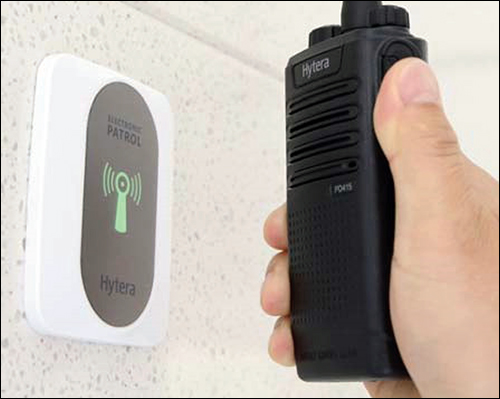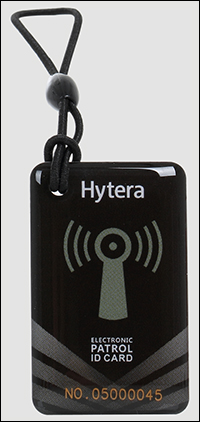RFID-Enabled Walkie-Talkies Help Track Remote Workers
时间: 2015-10-13 15:11
Hytera's PD415 radio and Patrol Management software enable companies to track where their workers are, and when, by having employees tap the handset against tags mounted at work sites.
By Claire Swedberg
Tags: Logistics, Security and Access Control
Banks, residences, hotels and logistics firms have begun using RFID-enabled two-way radios provided by wireless technologies company Hytera UK, to monitor the locations of its security guards and other personnel. Hytera's PD415 handheld two-way radio comes with a built-in RFID reader, designed to work in conjunction with Hytera's personnel RFID cards, RFID-tagged Patrol Checkpoints and Patrol Management software application, to manage each read event and make that data available to a company's management or clients as needed.
The PD415 radio was released in May of this year, says Martin Edwards, Hytera UK's head of product management. The radio's RFID technology is designed to monitor the locations of individuals who work remotely and are constantly on the move, such as guards, cleaners and maintenance personnel. The radio's built-in RFID reader module, designed and manufactured by Hytera, complies with the ISO 15693 standard.

The PD415 handheld two-way radio comes with a built-in RFID reader designed to work in conjunction with Hytera's RFID-tagged Patrol Checkpoint.
Hytera UK, a subsidiary of Hytera Communications Co. Ltd., is a distributor of Hytera wireless communications equipment, such as two-way radios used by security and maintenance personnel to stay in contact with their offices and with each other.

Hytera UK's Martin Edwards
This year, the company opted to add an RFID feature to one of its radios, in order to create a more visible trail of the movements of staff members who work at remote locations. "The radio was developed to improve the efficiency of guard tour systems, to reduce the number of devices that need to be carried and to allow real-time monitoring of the patrollers," Edwards explains.
Most companies use a predominantly manual method of tracking the movements of their personnel through remote locations. Individuals have assigned routes, and can check in via mobile phone or radio (such as a Hytera product) each time they arrive at, or leave, a specific location. Hytera's new RFID-enabled radios make this process automated.
With the Hytera system, a worker can be assigned a PD415 radio, and its reader module's own identifier can be linked to that individual. Alternatively, the employee can be assigned a Hytera Patrol ID card (model POA72) containing an RFID tag encoded with a unique ID number linked to that person. In the latter case, the worker taps the card next to his or her PD415, and the radio's built-in reader captures that individual's ID number and transmits it to an authorized Hytera MD785 radio or RD Series repeater. The MD785 radio or repeater then forwards the collected information to the application on a hosted server via a USB connection, where it can be linked to all read events for that shift and worker. According to Edwards, the application also sends a confirmation back to the staff member's PD415 to indicate that the data has been received.
At each location at which an employee is intended to report, such as specific rooms or facilities, there is a Patrol Checkpoint (model POA71)—a thin plastic panel measuring approximately 100 millimeters by 80 millimeters (3.9 inches by 3.1 inches) in size—mounted to a wall or other surface. Every Patrol Checkpoint has a built-in high-frequency (HF) passive RFID tag manufactured by Hytera. When the worker brings a PD415 radio to within about 40 millimeters (1.6 inches) of a Patrol Checkpoint, the handheld emits an audible beep to indicate that it has the unique ID encoded to that Patrol Checkpoint's RFID tag. That read data is sent to the server via the MD785 or repeater radio, thereby updating the software to indicate he or she was at that location.

A worker can be assigned a Hytera Patrol ID card containing a passive high-frequency RFID tag.
Each employee's assigned patrol routes can be entered into the application, enabling the manager or dispatcher to confirm that every Patrol Checkpoint is visited within the required span of time. In the event of an emergency, such as an employee not responding to radio calls, the system will indicate that individual's last known position, thus making it easier to locate him or her.
Hytera also offers an open application programming interface (API) allowing third-party software developers to produce their own RFID applications for its PD415 radio.
Since the system was released, numerous companies in a variety of industries have been using the radios, tags and application to identify where their workers are located, and when. None of these businesses have agreed to be named, however.
